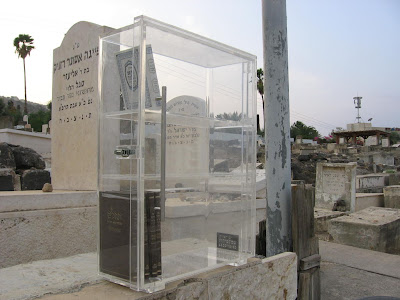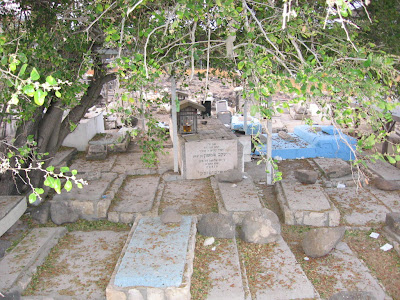Thank you all for your comments and questions on yesterday's post. They are of great interest to me.
Today let's continue the subject and look at some of the things which caught my eye as I roamed the ancient Jewish cemetery of Tiberias.
 My first time to see such memorial flames.
My first time to see such memorial flames. The oil + water probably can burn for a long time.
Also, mourners place a pebble on the earth that has been shoveled into the grave as they depart from a funeral.
 Prayerbooks are available in a rain-proof book case.
Prayerbooks are available in a rain-proof book case.
 The words of the prayer are large and clear so that a group of mourners who has just buried their dead relative can recite it in public, together.
The words of the prayer are large and clear so that a group of mourners who has just buried their dead relative can recite it in public, together.  This raised walkway over the graves must have been built recently to protect the sensibilities of the ultra-Orthodox. It separates the hundreds of mourners leaving the cemetery after a funeral into MAN [sic] and WOMEN.
This raised walkway over the graves must have been built recently to protect the sensibilities of the ultra-Orthodox. It separates the hundreds of mourners leaving the cemetery after a funeral into MAN [sic] and WOMEN.
 After finishing our archaeology work in early afternoon (the dig was just south of the cemetery), I would often stop in the cemetery to roam about, all alone.
After finishing our archaeology work in early afternoon (the dig was just south of the cemetery), I would often stop in the cemetery to roam about, all alone.
If you click to enlarge the picture, you see little notes among the piled stones.
The black is from the many little tea lights lit in his memory.
 Prayerbooks are available in a rain-proof book case.
Prayerbooks are available in a rain-proof book case.I assume this is the old Middle Eastern superstition that this shade of blue drives away "the evil eye."
 These names are not on graves but rather on a gal'ed, a memorial.
These names are not on graves but rather on a gal'ed, a memorial.
 These names are not on graves but rather on a gal'ed, a memorial.
These names are not on graves but rather on a gal'ed, a memorial. It speaks of the 19 "martyrs," largely women and children, who were stabbed and burned to death, some in the synagogue and some in their homes, when "raiding gangs of Arab rioters" infiltrated the Tiberias neighborhood of Kiryat Shmuel on October 2, 1938.
The 1936-1939 Arab revolt was a hard time for the Jewish residents of Palestine, then under the British Mandate; but the Tiberias massacre was especially shocking.
 The words of the prayer are large and clear so that a group of mourners who has just buried their dead relative can recite it in public, together.
The words of the prayer are large and clear so that a group of mourners who has just buried their dead relative can recite it in public, together.However difficult it is to understand why your loved one was taken away, the prayer Tziduk HaDin must be said, as a statement of our faith and trust in God's justice.
It speaks of God giving life to the dead.
.
Judaism does not have dogmas, especially not about future things that we have no way of knowing for sure.
Some believe in resurrection and some do not.
 This raised walkway over the graves must have been built recently to protect the sensibilities of the ultra-Orthodox. It separates the hundreds of mourners leaving the cemetery after a funeral into MAN [sic] and WOMEN.
This raised walkway over the graves must have been built recently to protect the sensibilities of the ultra-Orthodox. It separates the hundreds of mourners leaving the cemetery after a funeral into MAN [sic] and WOMEN.  After finishing our archaeology work in early afternoon (the dig was just south of the cemetery), I would often stop in the cemetery to roam about, all alone.
After finishing our archaeology work in early afternoon (the dig was just south of the cemetery), I would often stop in the cemetery to roam about, all alone.When the sun dropped behind the mountain, darkness fell quickly, reminding me it was time to return to the land of the living.
.





The photos are breathtaking, Dina, and the history behind them is quite interesting.
ReplyDelete"raiding gangs of Arab rioters" infiltrated the Tiberias neighborhood of Kiryat Shmuel on October 2, 1938. I think I saw a movie about this.
ReplyDeleteJewish cemeteries are beautiful. One was down the street from me when I lived in East Los Angeles. Several of the early movie makers are buried there.
(I would have called that color robbin's egg blue) Maybe that should be the chosen color of my Trash Tuesday lawn furniture.
I find the tradition of placing a stone on the tomb so very interesting! Do you remember the Schindler's List final scene?
ReplyDeleteIs it still possible to visit the Tomb of Maimonides?
ReplyDeleteFascinating photos of the ancient cemetery! I wish I could spend an afternoon there "exploring!" I'm visiting a Jewish family on Friday to take some Hanukkah photos for my blog for Dec 11!
ReplyDeleteFascinating posts, Dina, about the Tiberian cemetery. Old cemeteries can be beautiful and peaceful.
ReplyDeleteI also like to walk alone in cemeteries. Thanks for sharing the photos and history.
ReplyDeleteAnother excellent post.
ReplyDeleteI so look forward to my visits here, Dina.
Shalom
Comfort Spiral
It's a very nice cemetery, Dina. It's so interesting the shade of blue which drives away "the evil eye".
ReplyDeleteI found it interesting about putting rocks on the grave. In Japan we saw little pebbles being put on the torii. I'm still not quite sure what it signified. The rocks on the grave is really fascinating.
ReplyDeleteThank you for these two fascinating posts about the Tiberias tombs, Dina. I found every detail so interesting!
ReplyDeleteVery interesting! All new to me.
ReplyDeleteSo special
ReplyDeleteBeautiful post and pics.